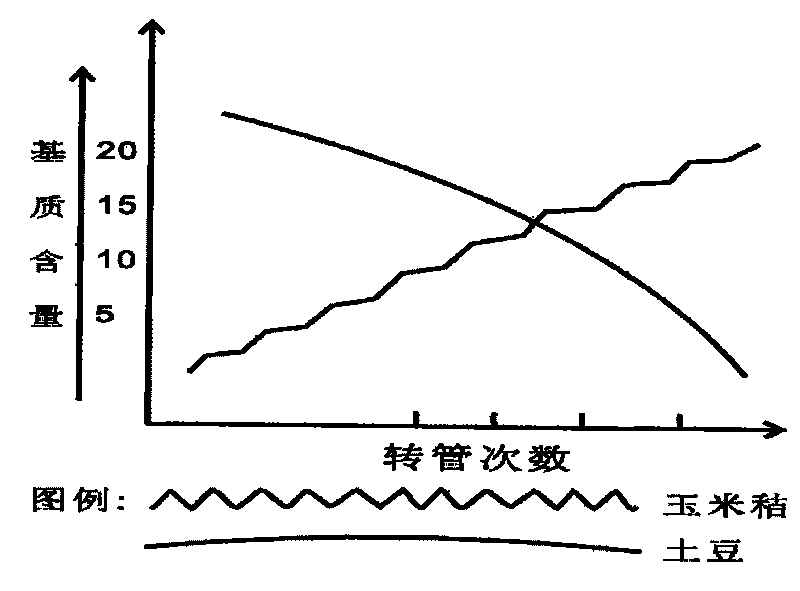Method for culturing stropharia rugoso-annulata and compost thereof
A technology of stropharia stropharia and compost, applied in botany equipment and methods, fertilizer mixture, gardening, etc., can solve the problems of no complete set of technology, retention, etc., and achieve the effects of saving energy, reducing contamination rate, and reducing costs
- Summary
- Abstract
- Description
- Claims
- Application Information
AI Technical Summary
Problems solved by technology
Method used
Image
Examples
Embodiment 1
[0028] Recipe: corn stalk 65, sorghum husk 16, wheat bran 8, cornmeal 2, soybean flour 2, salt 1, quicklime 2, potassium dihydrogen phosphate 2, gypsum 2.
[0029] Cultivation: (1) Mixing materials: Weigh the raw materials according to the above weight parts for later use, crush the corn stalks into soybean grain-sized particles, weigh out the gypsum and potassium dihydrogen phosphate, and press them into noodles, mix them with wheat bran, and mix well For standby, press the quicklime into powder, spread the corn stalks and sorghum husks on the cement floor, and sprinkle the mixture of cornmeal, soybean flour, quicklime powder, gypsum, potassium dihydrogen phosphate and wheat bran on the corn stalks and sorghum husks After mixing evenly, spread it on the cement floor, dissolve the salt with a small amount of water, add it to the raw materials and mix well, and pile up the stuffing for 2 hours. During the stuffing process, use the layered stacking method to turn the pile. After...
Embodiment 2
[0034] Recipe: 70 corn stalks, 15 beam husks, 9 wheat bran, 1 corn flour, 1 soybean flour, 1 salt, 1 quicklime, 1 potassium dihydrogen phosphate, and 1 gypsum.
[0035] (1) Mixing material: Weigh the raw materials according to the above weight ratio for later use, crush the corn stalks into soybean-sized granules, weigh out the gypsum and potassium dihydrogen phosphate and press them into noodles, mix them with wheat bran, and mix well for later use. Press the quicklime into powder, spread the corn stalks and sorghum husks on the concrete floor, sprinkle the mixture of cornmeal, soybean flour, quicklime, gypsum, potassium dihydrogen phosphate and wheat bran on the corn stalks and sorghum husks and mix well Then spread it on the cement floor, dissolve the salt with a small amount of water, add it to the raw materials and mix well, and pile up the stuffing for 1.5 hours. During the stuffing process, use the layered stacking method to turn the pile. The water content of the compo...
Embodiment 3
[0040] Corn straw 63, sorghum husk 17, wheat bran 10, corn flour 3, soybean flour 1, salt 1, quicklime 3, potassium dihydrogen phosphate 1, gypsum 1.
[0041] (1) Mixing material: Weigh the raw materials according to the above weight ratio for later use, crush the corn stalks into soybean-sized granules, weigh out the gypsum and potassium dihydrogen phosphate and press them into noodles, mix them with wheat bran, and mix well for later use. Press the quicklime into powder, spread the corn stalks and sorghum husks on the concrete floor, sprinkle the mixture of cornmeal, soybean flour, quicklime powder, gypsum, potassium dihydrogen phosphate and wheat bran on the corn stalks and sorghum husks and mix them After uniformity, spread it on the cement floor, dissolve the salt with a small amount of water, add it to the raw materials and mix well, and pile up the stuffing for 1.8 hours. During the stuffing process, use the layered stacking method to turn the pile. Adjusting the moistu...
PUM
 Login to View More
Login to View More Abstract
Description
Claims
Application Information
 Login to View More
Login to View More - R&D
- Intellectual Property
- Life Sciences
- Materials
- Tech Scout
- Unparalleled Data Quality
- Higher Quality Content
- 60% Fewer Hallucinations
Browse by: Latest US Patents, China's latest patents, Technical Efficacy Thesaurus, Application Domain, Technology Topic, Popular Technical Reports.
© 2025 PatSnap. All rights reserved.Legal|Privacy policy|Modern Slavery Act Transparency Statement|Sitemap|About US| Contact US: help@patsnap.com

